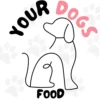Best Dog Food For Anal Gland Issues: A Guide to Happier Tummies
Anal gland issues in dogs can be messy and uncomfortable—think scooting, licking, or even infections. Diet plays a huge role in keeping these tiny glands healthy! Choosing the best dog food for anal gland issues can help your pup’s digestion and stool quality, which naturally supports gland function. Let’s break down how to pick the right food and keep your dog’s rear end trouble-free!
Introduction: Understanding Anal Gland Issues in Dogs
Anal glands are small sacs near your dog’s rectum that release scent-marking fluid. When stools are too soft, the glands don’t empty properly, leading to impaction, infections, or abscesses. The best dog food for anal gland issues focuses on fiber-rich diets to firm up stools and promote natural gland expression.
Signs and Symptoms of Anal Gland Problems
Scooting: Dragging their bottom on the floor.
Excessive licking or biting near the tail.
Swelling, redness, or foul odor around the anus.
Blood or pus in stool or near the glands.
How Diet Affects Anal Gland Health
Firm, bulky stools press on the glands during bowel movements, helping them empty naturally. Diets low in fiber or high in fillers (like corn) often lead to soft stools, worsening gland issues. The best dog food for anal gland issues includes quality fiber sources to keep digestion on track.

Top 5 Best Dog Foods for Anal Gland Issues
Hill’s Science Diet Perfect Digestion – Packed with pumpkin and barley for gentle fiber.
Royal Canin Gastrointestinal Fiber Response – Vet-recommended for stool quality.
Purina Pro Plan Focus Sensitive Skin & Stomach – Includes oatmeal and probiotics.
Blue Buffalo Wilderness High Protein Grain-Free – Features sweet potatoes for natural fiber.
Wellness CORE Digestive Health – Combines prebiotics and beet pulp for gut support.
High-Fiber Foods to Help Express Anal Glands Naturally
Pumpkin: Adds soluble fiber to bulk up stools.
Sweet Potatoes: Rich in digestible fiber.
Beet Pulp: A common stool-firming ingredient in kibble.
Oatmeal: Gentle on sensitive stomachs.
Wet vs. Dry Dog Food: Which is Better for Anal Gland Health?
Dry Food: Kibble’s crunchiness encourages chewing and often contains more fiber.
Wet Food: Higher moisture content helps hydration but may lack fiber.
Mix both or opt for high-fiber dry food as the best dog food for anal gland issues.
Grain-Free vs. High-Fiber Diets: What’s Better?
Grain-Free: Not necessarily high in fiber—focus on ingredients like peas or lentils.
High-Fiber: Prioritizes fiber-rich grains (oats, barley) or veggies (pumpkin, sweet potato).
Choose based on your dog’s needs: High-fiber diets win for gland support!
Best Protein Sources for Dogs with Anal Gland Issues
Chicken: Easily digestible for sensitive stomachs.
Salmon: Adds omega-3s to reduce inflammation.
Lamb: A novel protein for allergy-prone pups.
Avoid overly fatty proteins, which can upset digestion.
Homemade Diet for Dogs with Anal Gland Issues: Is It a Good Idea?
Homemade meals let you control fiber intake (e.g., pumpkin, brown rice), but balancing nutrients is tricky. Work with a vet to avoid deficiencies. Pre-made best dog food for anal gland issues is safer for most pet parents.
Supplements That Promote Healthy Anal Glands
Psyllium Husk Powder: Boosts fiber intake.
Probiotics: Improve gut health and stool quality.
Fish Oil: Reduces inflammation in glands.
Glandex Chews: Formulated specifically for anal gland support.
How to Transition Your Dog to a High-Fiber Diet
Switch gradually over 7–10 days:
Start with 25% new food + 75% old food.
Increase new food by 25% every 2–3 days.
Watch for firmer stools and reduced scooting.
Other Ways to Prevent Anal Gland Problems
Regular Exercise: Promotes healthy digestion.
Gland Expression: Ask your groomer or vet for help if needed.
Hydration: Ensure fresh water is always available.
Routine Vet Checks: Catch issues early!
Conclusion: Choosing the Best Dog Food for Anal Gland Support
The best dog food for anal gland issues prioritizes fiber, digestible proteins, and gut-friendly ingredients. Pair it with supplements and preventive care to keep your dog’s glands functioning smoothly. Remember, a happy tummy means a happy pup—and fewer messy surprises on your carpet!
